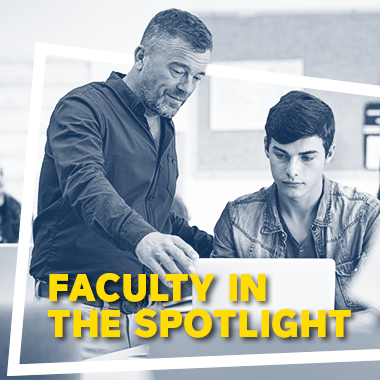Faculty in the Spotlight : Christine DI MARTINELLY, professor of Supply Chain management

With more than 700 professors, including 200 permanent professor-researchers, IÉSEG offers to its students a high-quality learning experience, based on 4 key elements: an active, interdisciplinary learning process, focused on the acquisition of competencies, offered through customized curricula.
Each month, “Faculty in the spotlight” invites you to meet one of the School’s professors who presents their vision of teaching, their methods for transmitting their expertise and passion to students and shares their best memories and stories at IÉSEG.
This month let’s meet Christina DI MARTINELLY, professor of Supply Chain Management at IÉSEG, on the Lille campus.
Christine, can you tell us about your background?
I studied in Belgium, at the Facultés Universitaires Catholiques de Mons, to become a management engineer. I then worked as a consultant for Arthur Andersen Business Consulting, a company that no longer exists. During this time, I also pursued my thesis on hospital management, more specifically on the organization of the hospital supply chain. I completed a dual academic path, obtaining a PhD in applied sciences from INSA Lyon and a PhD in economics and management from the Louvain School of Management.
I soon began teaching in Belgium, as part of a continuing education program. I gave courses to professionals who were resuming their studies in evening classes to obtain a degree in economics. While teaching, I quickly realized that theory had to be backed up by concrete examples to keep students engaged, as they were very keen on practical case studies.
What’s more, my own experience as a consultant, as well as my thesis conducted in collaboration with a hospital, enabled me to bring concrete illustrations to my classes, particularly in industrial management, a field closely linked to the supply chain.
Finally, a passion for teaching seems to be a tradition in my family, whether it be my parents, grandparents or other relatives, all of whom were involved in teaching in one way or another. I followed the trend and became a teacher myself.
Can you tell us about the subjects and courses you teach at IÉSEG?
I’m currently head of the Operations Management department and, until recently, I was also academic director of the Master in Business Analysis & Consulting (for eight years). I recently handed over to a colleague, as I felt it was time to make room for new ideas.
My courses focus on supply chain management. When we talk about supply chain management, we’re talking about inventory management, planning, scheduling and so on. It’s very operational. But there’s also a more strategic and tactical dimension, such as locating warehouses or factories to build an international distribution network. For me, the most appropriate definition of supply chain management is the management, through a network of upstream and downstream organizations, of the flows of materials, information and resources that lead to the creation of value in the form of products and/or services.
What teaching methods do you use?
I scruture my lessons in a logical way. At the beginning, I present students with concrete cases, often simplified, but based on real-life situations. We discuss the case and cover the key concepts. Then I suggest exercises to reinforce these concepts. Finally, I present a more complex case that the students have to solve on their own. This approach ensures a progressive and interactive understanding of supply chain concepts.
I also supplement the lessons by providing students with current press articles to illustrate the complexity of the supply chain and the importance of structured analysis. In short, I strive to show them the importance of a good overall understanding of concepts for in-depth analysis and problem-solving.
Why IÉSEG?
After living in Chile for two years, it was essential for me to join an international school, as this is an aspect that particularly appeals to me. When I discovered IÉSEG in 2010, although it was a small school at the time, it already had an international reputation. There were students from all over the world, and the big family atmosphere really seduced me. IÉSEG showed, and still shows today, a real concern for its students, ensuring that everyone can learn and achieve. Even back then, the school had put in place a whole range of tools to ensure that students stayed engaged and didn’t drop out. For example, we offered interactive courses, which differed considerably from my previous experience in Belgium and Chile, where I gave lectures to large groups of students, even in specialized subjects.
According to your students, what are your strengths as a professor?
I think my strengths as a teacher lie in the structure of my courses and the many exercises I give them. I always try to illustrate concepts with lots of practical examples. This is important, because although students are already doing internships every year, they are not always exposed to certain concepts, especially in the supply chain. So, I want them to be able to put what they learn into practice, by providing them with questions and exercises to help them apply sometimes complex concepts. I want to show them that they can do it. Students often appreciate the gradual progression in the difficulty of the exercises. They tell me they like this approach.
An anecdote to share with us?
I remember a student who was having a lot of difficulty with a number of subjects in my course, and who was feeling both lost and demotivated. We had a number of discussions in which I did everything I could to get her back on her feet, advise her and motivate her. Through hard work and determination, she was eventually able to successfully complete the course. Seeing her succeed, despite the difficulties she encountered, makes me particularly happy!



